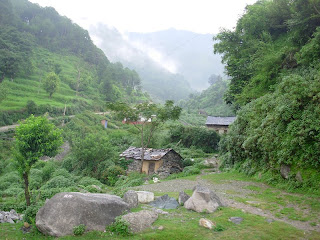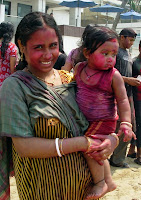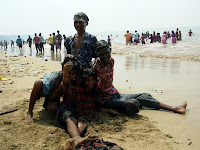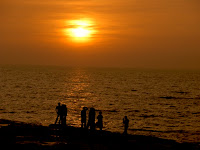When I was young and my grandmother still lived in Bombay, every visit to India would begin and end at her top-floor flat in the suburb of
Sion. It's the flat where my mother grew up, along with her parents, grandmother, three siblings, her father's brother, his wife and three cousins. And assorted domestic staff, natch.
Sion is in central Bombay, and borders the great slum of
Dharavi. The road from the airport would take us straight through Dharavi, and we always knew to wind up the windows and clutch hankies to our noses, so great was the sulphuric stench hanging over the area like a cloud. At the same time, we would peer out of the cab windows, curious to see as much as we could of the shantytowns and prefab buildings facing the street, hinting at the maze of alleys and dark underbelly contained within.
Since then, a network of flyovers has been built, making Dharavi a little more avoidable. Plus, I now live to the west of the island, so there's no need to travel through there.
This week, I finally entered to see things for myself. And I'm not alone:
Reality Tours, which run the Dharavi slum tours, say around 15% of their clients are Indians, many of them inhabitants of surrounding suburbs like
Mahim and Sion.
My friends are divided on the issue of the slum tours: some think it's poverty porn. But Reality Tours handle them extremely well and with great compassion. Taking photos is banned, and much of the profits go back in to the community in the form of an education centre. When the tours were first mooted, there was extensive consultation with the locals to ensure they were run according to their wishes.
Quoting official government figures, our guide Ganesh tells us the following facts:
- Dharavi's oldest building dates back to around 1840
- It is 1.75 square kilometres and Asia's biggest slum (oddly, this latter fact seems to be a point of pride)
- Inhabitants are around 40% Muslim, 35% Hindu and 5% Christian. Tamils are a large group among them, as are Maharastrians
- The slum's main industries are leather, pottery-making, plastic recycling and garment manufacturing
- Dharavi operates as its own, self-contained town: there are schools (government and private), hospitals, movie theatres, shops, and all basic essential services
- There are many NGOs operating in Dharavi
- Dharavi's official population is one million; however is estimated to really be around two and a half million
- Dharavi's annual GDP is about US$665 million
This last point is evident because the first thing I notice as we enter is that it's far more developed than I'd expected. There are proper paved roads with trucks and taxis hurtling down, vegetable markets on the sidewalks, and restaurants and makeshift movie theatres.
But then we turn down a narrow alleyway and, although the buildings are still properly fabricated, it becomes a little darker. We entered a plastic recycling area. Plastic that's foraged from all over the city, and even sent here from as far away as the US, is melted down, dyed and turned into little pellets, ready to be remodelled into toys or whatever. It's a sobering sight: a cramped warehouse, lit only by grubby skylights, containing about ten men operating various dangerous machines without any safety equipment. One man was doing something, soldering or similar, and staring with great concentration at the white flame that looked suspiciously like magnesium with his naked eyes. Another was feeding plastic through a machine with big rollers to flatten it, and presses himself closer to the whirring machine to let us pass.
Next, we see paint cans being recycled. A plume of dark smoke is in the air; Ganesh says to stay on the other side so we don't breathe the toxic fumes from the paint being burnt out of the cans.
Ganesh tells us that, despite the solid presence of NGOs, there are no unions nor OH&S requirements. Business owners pay off government officials. They then pay day wages of just Rs150 (about A$5) to workers who are too afraid or ignorant to speak up.
Later we see tiny workshops housing clothing manufacturers, where every available centimetre of floor space has children's clothes piled up. We see a one-room home slash factory where a man and his two young sons spend their days making women's shoes, then sleep on a mezzanine level at night. Then a bakery that's been in existence for more than 70 years and has been passed down the generations; there, we drink tiny cups of tea and chat in hybrid English-Hindi-gesticulations with the owner, a young guy who points to his flabby belly and tells us he's just two months pregnant.
We walk through tiny alleyways in the residential area but don't go in to any homes, however pick up a trail of young kids in a Pied Piper-like fashion. Then outside, in an area that seems to be a kids' playing yard, leather tannery, big outdoor latrine and garbage tip all in one, Ganesh points out neighbouring apartment blocks built twelve years ago to rehouse some of the Dharavi inhabitants.
"Bill Clinton came to Bombay for the inauguration," he says.
"But they cleaned up all this for his visit," he adds, pointing to the garbage, where at that moment, appropriately, a little boy is taking a dump.
He then introduces us to a gaggle of men sorting through some leather pellets. Dharavi's leather specialists are said to be amongst the best in the world. By feeling the leather they can tell you what sort of animal it came from, whether the animal died naturally or from some sort of disease, whether it was pregnant at the time and whether it was male or female. Top earners can fetch about Rs500 per day (A$15).
Ganesh, poker-faced, tells us that leather is Dharavi's top industry and many foreign companies get their leathergoods manufactured here. "Even Gucci, Versace, big labels like that."
At first I think he's talking about fakes, but when I ask if we can go and take a look he shakes his head. Apparently companies are uber paranoid about the outside world seeing the conditions their bags are made under, that security is extremely tight. Even workers not wearing ID badges aren't allowed in.
Surprisingly to me, it's all relatively hygenic* and clean, no worse than any other part of Bombay. There are wide streets, English-medium schools, and children in school uniforms swinging down the street. Away from the horrific conditions of the industrial areas, people appear no more afflicted, malnourished or mistreated than in any where else in the city.
Nevertheless it would be remiss to suggest that Dharavi is some kind of utopian paradise that has jobs aplenty for desperate migrants from the impoverished countryside. It's a pretty unpleasant place to live and work. Plans for urban renewal are in hiatus thanks to corruption, so even though Dharavi is due to be torn down, it's not clear when, or if, this will happen. Residents who have been there since before 1995 will receive a home, those who've settled since then will have to make their own arrangements.
I'm not easily moved by poverty or squalor - middle-class Bombay blood runs deep - and I'll admit I wasn't left 'depressed' by the tour. Rather, uncomfortable and pissed off. Uncomfortable because it's hot and cramped in there! It's like being in a medieval village! And pissed off because there's so little option for people lower down on the food chain to have dignity. How do you progress from earning Rs150 a day? How do you save for the future, plan to have kids, buy yourself anything but the most basic of food? How do you attend to human needs on that amount? When do you see trees, the sun, the coast? And what do you do when your dangerous work conditions leave you with lung cancer, or blind?
What's the point of even trying to survive when it means living that sort of life?
There's a lot more that can be said about poverty and desperation in Bombay, but I feel much of it has been said before, by people more knowledgeable, analytical and lyrical than myself. Before
The White Tiger there was
A Fine Balance, which did what Aravind Adiga did, but 14 years earlier and better. And before Slumdog Millionaire there was
Salaam Bombay! which was great (even though I find Mira Nair pompous and irritating).
Read it, see it, come back and discuss.
*Relatively: there are open sewers lining the streets of the main tourist area close to the Taj Mahal in Agra, and through Fort Cochin. There are small open sewers running through Dharavi but for the most part they're enclosed. I saw no rats in Dharavi; I've seen rats scampering through the streets of Colaba near the Gateway of India.


































